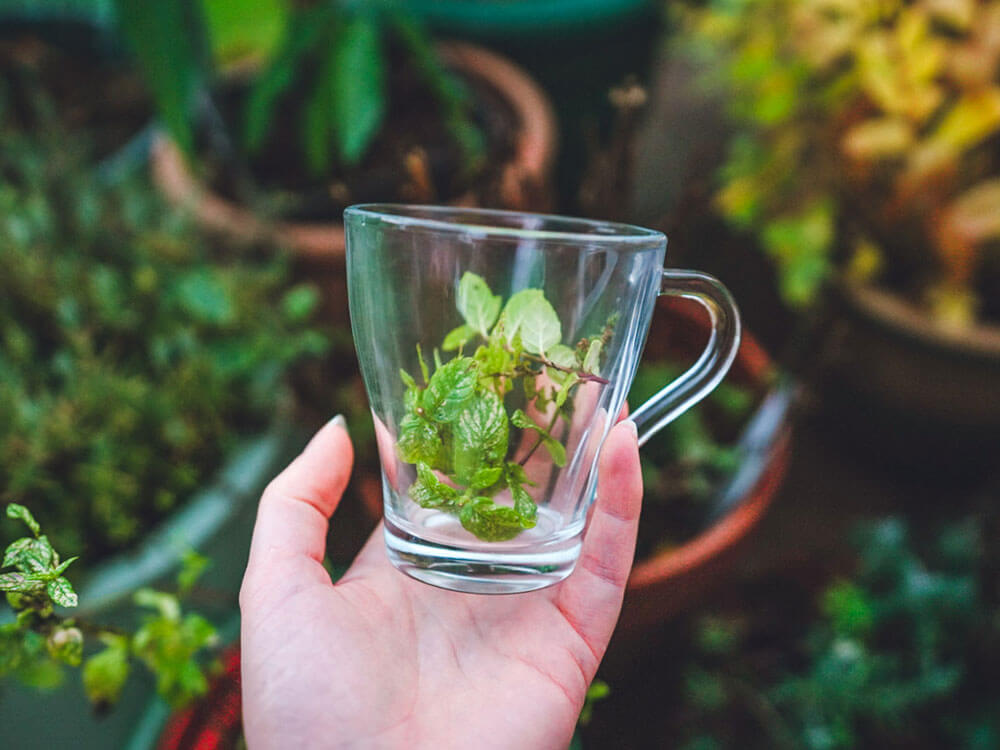14 Healing Herbs to Grow in a Balcony Garden
October, 2022 |Thinking of stocking your balcony or backyard with a source of natural remedies? There are so many attractive and easy-to-grow medicinal herbs that you can keep in containers.
These medicinal herbs can make your small garden space look and smell amazing, but they’ll also provide you with a self-sufficient source of simple healing ingredients.
From balconies to window boxes, growing medicinal herbs in containers is ideal in small garden spaces. Because of their growing habits and small size, you can easily maintain your own mini balcony apothecary.
We usually think of herbs in our gardens as a source of fresh ingredients. Culinary herbs like basil and cilantro are popular windowsill herbs that we like to keep on hand to add to recipes.
But there are lots of amazing herbs that have amazing medicinal uses too!

Disclaimer: Before using herbs make sure you do thorough research on the plant and never consume too much. Like any medicine, herbs can have side effects, cause allergic reactions and even conflict with medication you already take. Generally, if you’re pregnant, breastfeeding, or ill with a serious condition, you should consult a trusted healthcare professional before taking medicinal herbs. Studies and information on the amazing potential of medicinal herbs is growing, but they’re not as widely tested as some other medications.
The benefits of a medicinal herb container garden
Medicinal herbs have always had a valued place in cultures and gardens around the world for centuries. Even the classic garden design style of the cottage garden revolved around keeping useful herbs on your doorstep instead of trading or foraging them from the wild.
Today, many age-old herbal remedies are backed up by rigorous scientific studies that are confirming the traditional uses of plants. This list contains some of the oldest, most valued, and also most studied medicinal herbs.

How to use medicinal herbs from your container garden
Dried or fresh, from tinctures to teas, each herb has a different method of preparation. Fresh is usually best, as the beneficial compounds are more potent, but some herbs can be dried or made into a homemade tincture for later use too. This is really useful when you want to use the herb out of season.
They also have different application methods, so we’ve listed how to use each herb too.
14 healing herbs you can grow in containers on your balcony
Every herb on this list is really easy to use in homemade applications. You don’t need any expensive distillation or kitchen equipment. Just a selection of containers, compost, and seeds (or potted plants from a nursery!).
So here are 14 of the most widely used medicinal herbs that you can grow in your container garden — and how to use them!
1. Pot Marigold (Calendula)
One of the most traditional cottage garden flowers. Pot marigolds (Calendula officinalis) were both a beautiful garden flower and a useful medicinal and culinary herb to keep on hand.
They’re extremely easy to sow from seed, whether you buy seed packets or collect the seed to resow them the following year!
Studies have shown that active compounds within Calendula contain anti-inflammatory and even anti-fungal properties.
Calendula is also a popular cosmetic herb too. Combined with chamomile it can create a herbal hair rinse.
How to use pot marigolds at home:
- add them to a herbal foot bath to soothe swollen or achy feet
- create an ointment to help fade old scars
- infuse the petals into a tea to improve circulation (especially for varicose veins)

2. Lavender
Another classic cottage garden plant, the scent of lavender is well known for its deeply relaxing properties. It was traditionally used in cosmetics and also added to drawers to keep moths away!
Lavender bushes are easy to grow and maintain, and they can benefit pollinators as well as our health.
Recent studies have suggested that lavender can reduce anxiety, provide mild pain relief and even have a mood-stabilizing effect.
How to use lavender at home:
- The scent of lavender can promote relaxation and restfulness. Using lavender in facial steam is a popular cosmetic use of lavender.
- A cold compress with lavender flowers can ease headaches
- Collect dried lavender in a muslin bag and add to baths to ease muscle and joint pain

3. Hyssop
A member of the mint family, hyssop (Hyssopus officinalis) has been used as a medicinal herb for hundreds of years.
Active compounds in hyssop are believed to have an expectorant effect (clears the sinuses!). It also has antiseptic properties too which can help with the healing process of respiratory illnesses.
How to use hyssop at home:
- Use leaves in a tea infusion to treat coughs, sore throats, and colds
- A compress with hyssop leaves can be used to treat sore muscles.

4. Common Sage
Not just for flavoring savory dishes! Many herbs have a multi-use application and sage is a great example. We usually think of sage (Salvia officinalis) as a culinary herb, but it actually has a long history as a medicinal.
You can use sage in lots of different ways as it contains plenty of beneficial compounds. It has antiseptic and also antioxidant properties.
How to use common sage at home:
- Create a soothing tea with sage leaves to treat coughs and colds
- A sage infusion can also be used to treat constipation

5. Lemon Balm
Another member of the mint family, lemon balm (Melissa officinalis) has been used for centuries. Even today, ‘Melissa tea’ is still a popular homeopathic recipe in France.
Lemon balm is originally native to the middle east, so it’s definitely another herb that needs to be placed in a container in full sun.
How to use lemon balm at home:
- Lemon balm leaves can create a soothing tea to treat headaches, fatigue, anxiety, and indigestion.

6. Rosemary
One of the most versatile herbs on the list, rosemary (Salvia rosmarinus) is a great culinary and medicinal herb to keep on hand. Even if you only have a small window box, its fragrant leaves, and purple flowers are definitely a must-have.
Although a popular cottage garden plant, it’s originally native to southern Europe and the middle east so make sure you keep its container in the sunniest place in your garden.
It was traditionally used to treat conditions varying from headaches and muscle spasms to anxiety and depression. Recent studies have shown that rosemary contains many beneficial compounds, including, antioxidants and anti-inflammatory compounds.
How to use rosemary at home:
- You can create a tea with fresh rosemary leaves to treat colds, improve circulation and relieve headaches.
- A topical application of rosemary could also provide mild pain relief to aching muscles.
7. Marshmallow
The original recipe for the pink fluffy sweets we know and love today was inspired by an old candy recipe that included the marshmallow plant (Althaea officinalis).
Marshmallow leaves, flowers, and roots were all valued as traditional herbal medicine. These plant parts contain a high mucilage percentage which has been linked to their ability to create a protective coating when applied to the skin or drank as a tea.
It’s a hardy perennial so once you’ve potted it up, it should return each year. The pink flowers are really attractive and overall it’s a useful medicinal herb to have on hand.
How to use marshmallow at home:
- Gargling an infusion of marshmallow leaves can soothe a sore throat
- You can also create a poultice of the flowers and leaves to soothe skin irritations and inflammation.
- Shavings of marshmallow root can be boiled into a tea to treat mucus coughs.

8. Yarrow
With clusters of tiny white or pink flowers, this sweet little plant has a long history of use in Native American culture. It was taken to relieve pain, treat headaches and fever, and also small cuts.
Yarrow (Achillea millefolium) grows in the wild across most of the Northern hemisphere. But it’s easy to grow from seed at home too!
How to use yarrow at home:
- Add the leaves to a tea to soothe a headache or cold. Strong yarrow tea has been traditionally used to bring down a fever.

9. Chamomile
Fancy making your own home-brewed chamomile tea? The sweet-scented daisy-like flowers of German chamomile (Matricaria chamomilla) could be a cheerful addition to a small garden space.
Fresh chamomile flowers contain Chamazulene, an active compound that can reduce inflammation. Studies have also indicated that drinking chamomile tea can reduce anxiety.
Chamomile may cause an allergic reaction in some (especially if you’re allergic to ragweed). It could also interact with blood thinners, so consult your doctor before taking it.
How to use chamomile at home:
- Steep the flowers in hot water to create a relaxing tea that can reduce anxiety and help to settle indigestion
- Add the flowers to a bowl with hot water to create facial steam to soothe a headache

10. Borage
Borage (Borago officinalis) is a great plant for bees, but it has many great medicinal properties too.
Traditionally borage was used to treat various parts of the body, from the kidney and liver to the gastrointestinal tract. But it was most frequently used to treat fevers.
Recent studies have isolated lots of antioxidants and anti-inflammatory properties which explains its use in reducing fevers.
How to use homegrown borage:
- Add the leaves and flowers into a healing tea to reduce a fever
- Apply a poultice of crushed borage leaves to insect bites, bruises, and areas of swelling to reduce inflammation.
11. Peppermint
There is something so grounding about the scent of mint. There are several mint varieties, but spearmint (Mentha spicata) and peppermint (Mentha × piperita) are usually the easiest to buy.
Mints have vigorous roots, so growing them in containers makes them easy to manage and less likely to take over a small garden!
How to use homegrown mint:
- Add the leaves into a healing tea to aid digestion
- Gently rub fresh leaves across the forehead to soothe a headache
- Create a homemade tincture or spearmint oil to apply to bruises, toothache, and muscle sprains.

12. Fennel
The leaves of fennel have an anise flavoring and are a popular culinary herb. However, fennel (Foeniculum vulgare) has long been used as a medicinal herb too.
Traditionally it was used to aid digestion and also improve eye health and recent studies have shown fennel essential oil has a high number of antioxidant and antimicrobial effects.
How to use homegrown fennel:
- Add the seeds into a healing tea to soothe indigestion, stomach cramps, and bloating

13. Echinacea
Echinacea (Echinacea purpurea) is a valued herb in many Native American groups. It was traditionally taken to soothe and treat a range of conditions, from toothache and colds to mumps and arthritis — and also as a treatment for snakebites.
Today it’s a herb that’s hugely valued for improving overall immune function and the treatment of respiratory conditions (like coughs and colds).
The beautiful purple flowers are high in vitamin C and studies have confirmed their anti-inflammatory and antibiotic properties. It’s definitely a beautiful and useful herb to keep on a balcony, add it’s a great plant to attract Monarch butterflies too.
How to use homegrown echinacea:
- Add the leaves and petals to a healing tea.
- Create a tincture with the roots, petals, and/or leaves, and add 1-2 drops into a glass of water to drink.

14. Hops
Hops (Humulus lupulus) are a great vertical vegetable plant that also has medicinal benefits too. Hop flowers are most famously known as a flavoring in beer, but they had importance as a homeopathic herb too.
Traditionally they were used to calm the nerves, and they have always been strongly linked to promoting better sleep.
They’re a vining perennial plant, so add vertical supports behind their container (like a trellis) and they’ll soon provide attractive coverage.
How to use hops at home:
- Dried hop cones infused with hot water can create a soothing drink to combat insomnia
- Keep dried cones in a pouch near the pillow to help with sleeplessness

Tips for growing medicinal herbs in a container garden
Trimming a small amount of the herb regularly can keep the plant healthy and continuously putting out new shoots and flowers. Other tips include…
- Some of the herbs on this list are originally native to warmer climates, like the Mediterranean, so will thrive when placed in the sunniest spot on your balcony or a small garden.
- As small shrubs or flowers, many of these herbs will benefit from being placed in a sheltered place away from high winds.
- Keep them in an accessible and easy-access place near a door or window. This will help when it’s raining and you don’t want to wander out into your garden!
- You could plant multiple herbs in larger containers, for example, shade-loving plants like mint and parsley could be grown together.
Whether you grow a mixed floral window box of echinacea and chamomile or a planter filled with peppermint, lavender, and marshmallow. Growing your own natural remedies in garden containers is a great way to become more self-sufficient and in tune with nature.






